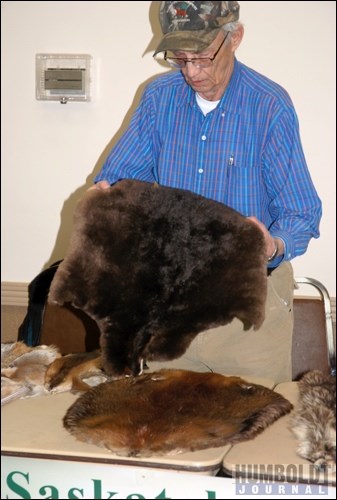Traps, pelts, skinning and boarding - where else will you hear those terms all together than at a convention for trappers?
The Saskatchewan Trappers Association (STA) held their 43rd annual convention and meeting at the Bella Vista Inn in Humboldt February 17-18.
Interest in trapping is stronger now than it has been in the past 10 to 15 years, noted David Weiman, a trapper and member of the STA.
"There's renewed interest in it, from all walks of life."
Typically, noted Don Gordon, president of the STA, they get between 80 and 100 people stopping by the convention on Friday - when they hold their annual meeting - and between 125 and 150 on Saturday, which is when they hold workshops, demonstrations of skinning and boarding, fur competitions and their banquet.
Education is a large part of the convention, and not just for the trappers. The STA loves it when classes from local schools drop in to hear about trapping, as one did last week.
Part of the Grade 5 curriculum is learning about the fur trade, Gordon said, so they try to expand on that.
"To have kids here is key for us," he said.
Using pelts, they lead the children through descriptions of the fur-bearing animals of Saskatchewan, describing the diet and habitat of each one, from the black bear and wolf down to the smallest weasel and rodent.
During the lecture, the children learn how controls are needed to conserve animal populations, and how regulated trapping helps with that.
In this way, animal populations are kept healthy, and not threatened by disease.
"If animals get too thick," said Cordell Cross, the education coordinator for the STA, "nature will deal with it through starvation or disease, like mange. We're called trappers, but I like to be referred to as wildlife managers. That's what we try to do."
"Trapping is fur management," Gordon agreed. "That's the reason why we have an abundance of fur-bearing animals in this province - because of fur management. We're teaching that aspect."
Bounties on animals, like the ones on beavers and coyotes that have been issued in the recent past, are something the trappers don't like, as they result in waste.
Though animal rights activists have hurt the fur market, it seems to be undergoing a resurgence in popularity as the prices for furs are getting stronger.
"This year, we're seeing really good prices on furs," said Gordon. "There's a buzz in the air that we're going to see some money this year."
There are just two fur auction companies left in Canada, and both had representatives at the convention.
Mel Stocking, a representative of the North American Fur Auction noted that prices for muskrat and coyote pelts have risen substantially in the past 10 years.
Humboldt has hosted the STA convention event for at least eight out of the last 10 years.
"Humboldt is central in the province... and the hospitality here is the best we've ever seen. You can't beat this staff."
For their small organization, the price of hosting a convention here is right, as well, he said, and the small city has been very welcoming to their membership.
"People know we're here. It's great," Gordon said.




